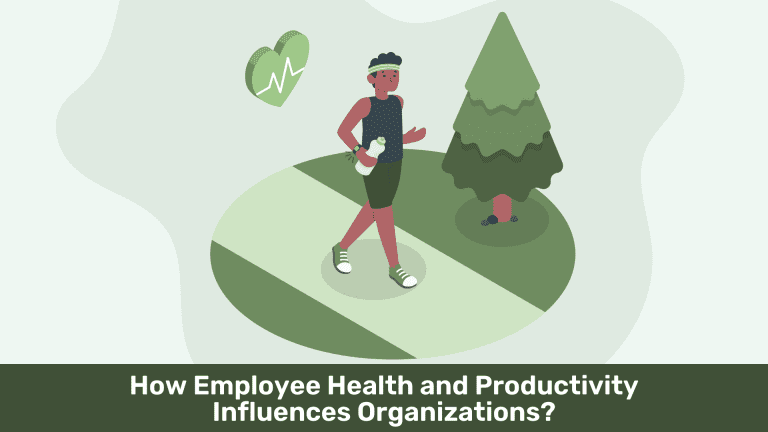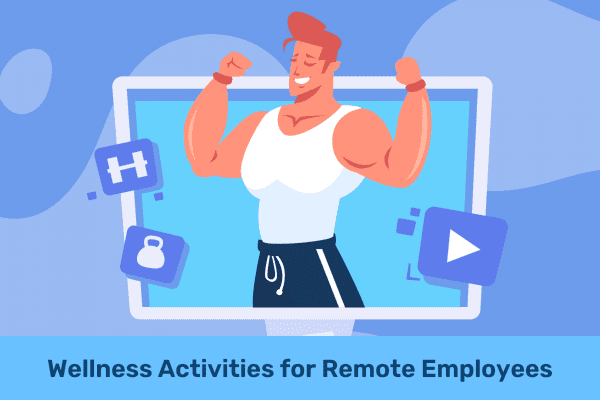Employee health and productivity are big keys for a successful company. Unfortunately, in the United States, this can be easier said than done.
This is because 94% of service professionals in this country work over 50 hours per week.
If you are someone that owns a company reading this, you may be concerned about employee productivity. You could be taking the first step to getting to the bottom of it.
How can employee health improve your organization? Will it help improve employee productivity? How does it impact your workforce morale?
This is your guide.
What is meant by Employee Health?
Employee health refers to the physical, mental, and emotional well-being of individuals in the workplace. It encompasses various aspects of health, including physical fitness, mental wellness, and the ability to cope with work-related stressors.
Physical health: This aspect of employee health focuses on the individual’s physical well-being, such as their overall fitness, strength, and vitality. It includes factors like maintaining a healthy weight, engaging in regular exercise, and practicing proper nutrition. Promoting physical health can help reduce the risk of chronic diseases, improve energy levels, and enhance the overall quality of life.
Mental health: Employee mental health refers to an individual’s emotional and psychological well-being in the workplace. It involves managing stress, maintaining a positive mindset, and coping with work-related challenges. Organizations that prioritize mental health create supportive environments, provide resources for stress management, and promote work-life balance to foster a positive and resilient workforce.
Emotional health: Emotional health relates to an individual’s ability to recognize, understand, and manage their emotions effectively. It involves building emotional intelligence, fostering positive relationships with colleagues, and creating an emotionally supportive work environment. Emotionally healthy employees are more likely to handle workplace conflicts constructively, communicate effectively, and maintain positive morale.
Employee health is a holistic concept that recognizes the interconnectedness of physical, mental, and emotional well-being. By investing in employee health, organizations can enhance productivity, reduce absenteeism, and create a positive work environment that contributes to the overall success of the organization.
Relationship between Employee Health and Productivity
1. Desiring Work-Life Balance
One thing that employers should be aware of is that most employees want to maintain a life outside of their job. When most service professionals are working over 50 hours per week, this can be very difficult to achieve.
It can leave them too tired at the end of their workdays to do anything else. This could also get them to put off doing certain responsibilities and cutting back on their social lives.
However, work-life balance tends to be one of the biggest things that employees look for when they are seeking a job. About 72% of employees do this.
If employers like you become aware of this, then you need to use this stat and try to give your employees more opportunities to achieve this. You can start by restricting the number of hours they work per week.
An example can be encouraging employees to go home after working their regular 9-5 shift. Or, you can discourage employees from working on the weekends and encourage them to spend time with their families.
Companies that take this action may see positive results.
2. Feeling Refreshed
As stated above, employees tend to desire a work-life balance if they have the opportunity to achieve that. One of the biggest benefits for both employees and companies is that they are more likely to come to work refreshed and ready to go.
An example of this can be making sure that employees get enough rest before they come to work. This relates to the above about how it may not be the healthiest thing for employees to work overtime.
The reason for this is that it can result in a lack of sleep. When a lack of sleep happens, it makes the human body less functional.
In the United States, a lack of sleep costs companies over $411 billion per year! That adds up to over 1.2 million working days annually.
Lack of sleep also increases the risk of mood swings and even obesity for people. Most working adults should be striving for at least seven hours of sleep every night. However, they should make sure that they are getting a minimum of six hours of sleep before the sleep deprivation effects really start to show.
3. The Chain of Command
It is no secret that some employees absolutely despise their bosses. There could even be an employee that does not like you if you own a company.
For a lot of employees, this can be a big setback when it comes to trying to achieve a work-life balance. Over 13% of employees believe that this is the biggest barrier that they have when they are trying to achieve this.
So, what can you do? For starters, you can try to see where you need improvement as a boss or an owner for those middle managers.
Some people believe that a team is only as strong as its weakest link. What you need to do is make sure that everybody feels like they can perform at their best. That starts by reassuring those middle managers.
Then, those managers have to spread that energy to associate employees. They are likely going to be the ones that have the most direct impact on the majority of your employees.
As a result, it is important that you are not giving those employees a manager that is difficult to work with. However, part of this responsibility is on you to ensure that your manager does not have a more difficult job than it needs to be.
Address your chain of command and see where it could use some tightening up.
4. Employee Retention
Another thing employers need to think about is how the work environment impacts employee retention. If they are not careful, too much employee turnover can cost the company a lot of money.
The cost of a company losing an employee equates to about 33% of their annual salary. So, if an employee was making $100,000 a year at your company and then decided to quit, your company would lose about $33,000 in revenue.
What if 10 employees of that stature decided to quit around the same time? Now, your company is talking about losing hundreds of thousands of dollars.
However, your pockets are not the only thing impacted by high employee turnover. It also takes time and energy to go through the hiring process all over again. You can spend weeks looking for the right candidate to take their place and then, somebody has to spend time onboarding them and training them.
This results in a ton of work hours lost just by replacing the employee. On top of this, it hurts team chemistry tremendously if this happens too often.
Think about it. A sales team may have 10 people on it and they spend a couple of months working together well. Then, two of them suddenly quit and the team suddenly finds themselves short-staffed.
The team is stressed from covering their work and when they finally get two new employees, they do not end up being the same fit as the old team members. This results in a decrease in employee morale, insecurity, and more stress.
Employers need to find more ways to retain good employees. One of those ways is by addressing employee health along with their needs outside of work.
5. Attracting Better Talent
Employee health is not just important to address for those that already work for you. If you play your cards right, it can also help draw better talent that does not work for you yet.
Changing your company culture can help draw in college students that hear positive things about your company. It can also draw the attention of other employees in your industry that are looking for a change.
We discussed above how important work-life balance is for employees. Let’s say that there is a top employee in the local industry that is not happy with their work-life balance in their current position.
You can approach them and offer them a full-time job with similar salary and benefits. However, the catch is that they would not have to take as much of their work home with them. Also, if they hear through the grapevine that employees are happy working at your company, that may play a big part in making a change.
Yes, employees do care about their pay and their benefits. However, employees also do care about their wellbeing. Top employees know this and may actively want to make professional changes that improve their overall morale.
6. Creating a Bond
Finally, encouraging employee health may result in more bonds being formed between co-workers. Part of this can be because a company culture has been put into place that your employees buy into.
Also, if employees are healthier, they may see themselves feeling more refreshed and more positive overall. This can increase their likelihood of being outgoing to their co-workers and being on the same page with the rest of their team.
As a result, you can see friendships start to form in your company. This can mean that employees have some sort of attachment or investment in your company. On top of this, it can improve the team chemistry that we were discussing above.
The bond can be that employees believe in taking care of themselves and they share your vision to take the company to the next level.
Effective ways to encourage employee health in the workplace
- Promote Work-Life Balance: Encourage employees to maintain a healthy work-life balance by setting reasonable work hours, promoting flexible schedules, and respecting personal boundaries. This helps prevent burnout and allows employees to engage in activities that promote their overall well-being.
- Provide Wellness Programs: Implement wellness programs that focus on various aspects of employee health, such as physical fitness, nutrition, stress management, and mental well-being. Offer resources, workshops, and activities that support healthy lifestyles and provide opportunities for employees to engage in regular exercise and self-care.
Also Read:
Creating a Corporate Wellness Program for Employees
- Create a Supportive Work Environment: Foster a culture that values employee health by creating a supportive work environment. Encourage open communication, provide resources for mental health support, and promote a positive atmosphere where employees feel comfortable seeking assistance or sharing concerns related to their health.
- Encourage Regular Breaks: Encourage employees to take regular breaks throughout the workday. Short breaks for stretching, walking, or mindfulness exercises can help improve focus, reduce stress, and increase productivity. Provide designated areas where employees can relax and recharge.
Read Further:
Top 8 Energizing Brain Breaks for Adults Ideas
- Offer Healthy Food Options: Provide nutritious food options in workplace cafeterias or vending machines. Encourage healthy eating habits by promoting the availability of fruits, vegetables, whole grains, and low-sugar snacks. Consider organizing healthy eating challenges or providing nutrition education sessions.
Read Further:
15 Fantastic Brain Food Snacks to Boost Productivity at Work
- Support Physical Activity: Encourage physical activity by offering incentives for participation in fitness challenges, providing on-site fitness facilities or gym memberships, and organizing group exercise sessions or walking meetings. Encouraging physical activity during the workday can boost energy levels, improve mood, and enhance overall well-being.
- Communicate and Educate: Regularly communicate and educate employees about the importance of health and wellness. Share information through newsletters, bulletin boards, or internal communication channels. Offer educational workshops or seminars on topics like stress management, nutrition, or ergonomics to increase awareness and knowledge.
- Lead by Example: Leadership plays a crucial role in promoting employee health. Lead by example by prioritizing your own health and well-being and encouraging other leaders and managers to do the same. When employees see leaders actively engaging in healthy behaviors, it motivates them to follow suit.
- Provide Employee Assistance Programs: Offer access to employee assistance programs (EAPs) that provide confidential counseling services for various issues, including mental health, stress, and work-life balance. EAPs can support employees in managing personal challenges that may affect their overall well-being and performance.
- Recognize and Celebrate Employee Achievements: Acknowledge and appreciate employees who actively participate in health and wellness initiatives. Celebrate milestones, recognize progress, and provide incentives or rewards to promote continued engagement and motivation.
Improve Employee Health and Productivity
These are some of the biggest reasons why employee health and productivity are so important to a company’s success. A company that addresses these two things is very likely to see some positive results.
It can result in higher team chemistry, more bonds between employees, a higher employee retention rate, more respect for the chain of command, a better work-life balance, and more.
If you do not know where to begin, our platform can help you manage this. Schedule a demo here to see how we can help.






